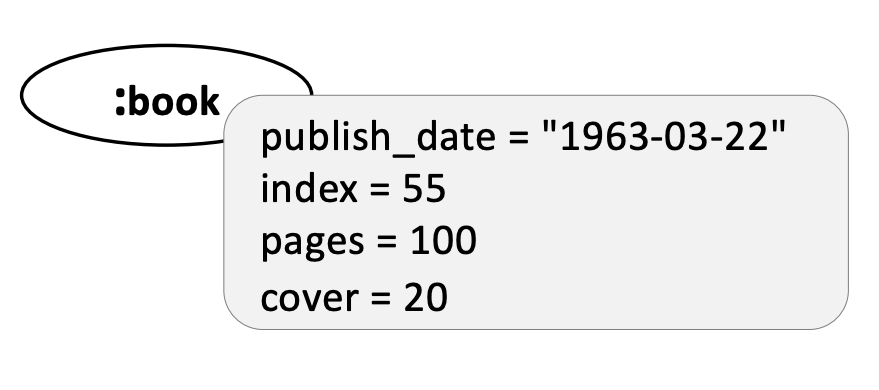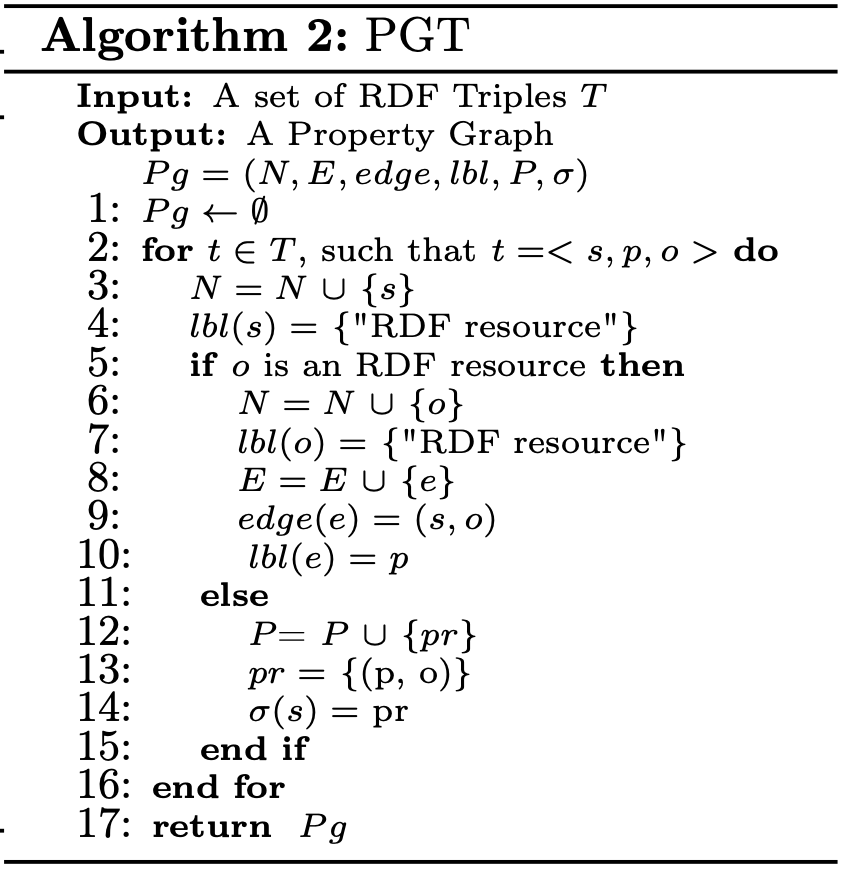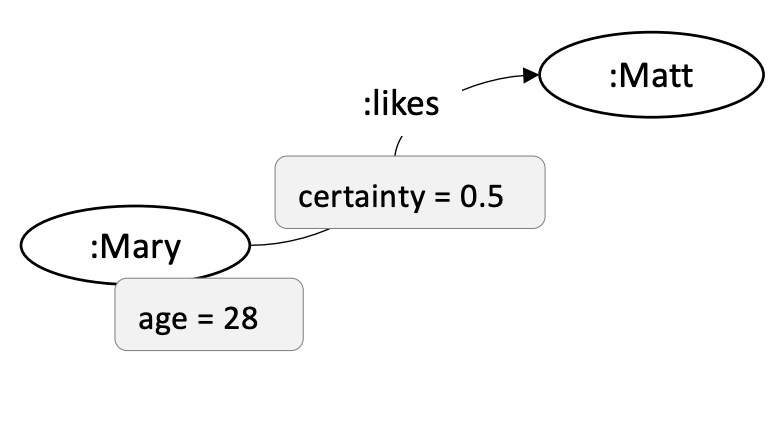RDF to ArangoDB (PGT)
Same graph, but lighter
What is PGT?
PGT ensures that datatype property statements (i.e statements whose objects are Literals) are mapped to node properties in the Property Graph (PG).
Consider the following RDF Graph:
@prefix ex: <http://example.org/> .
@prefix xsd: <http://www.w3.org/2001/XMLSchema#> .
ex:book ex:publish_date "1963-03-22"^^xsd:date .
ex:book ex:pages "100"^^xsd:integer .
ex:book ex:cover 20 .
ex:book ex:index 55 .
PGT creates a PG consisting of a single node respresenting the RDF resource (ex:book) with
multiple properties representing property-object pairs from the RDF statements, such as (ex:index,55).
Distinguishing between datatype and object property statements, this approach transforms object
property statements to edges and datatype property statements to properties of the node representing the subject.
Unlike RPT, the resulting PG nodes represent only RDF resources or blank nodes while Literal Objects will
become properties:

The Algorithm belows formalizes the PGT approach. For each triple, check the type of the statement’s object (line 5), and based on that, decide to either create a node (if it does not yet exist, line 6) or a property (line 13).

Now, consider the following RDF-star Graph:
@prefix ex: <http://example.com/> .
<< ex:Mary ex:likes ex:Matt >> ex:certainty 0.5 .
<< ex:Mary ex:age 28 >> ex:certainty 1 .
PGT transforms the embedded triple depending on its object; if it is an RDF resource, PGT converts it to an
edge. Otherwise, it converts the embedded triple into a node with a property
(lines 6-11) and fails to transform the asserted triple. The transformation of the triples from using PGT
results in a PG with a single node that makes it impossible to represent the (ex:certainty 1) triple,
since PGs do not support properties over other properties:

Please Note: The rdflib python package hasn’t yet introduced support for
Quoted Triples, so
ArangoRDF’s support for RDF-star is based on Triple Reification.
As a result, the RDF-star Graph above can be processed with ArangoRDF as follows:
from rdflib import Graph
from arango import ArangoClient
from arango_rdf import ArangoRDF
data = """
@prefix ex: <http://example.com/> .
@prefix rdf: <http://www.w3.org/1999/02/22-rdf-syntax-ns#> .
# << ex:Mary ex:likes ex:Matt >> ex:certainty 0.5 .
# << ex:Mary ex:age 28 >> ex:certainty 1 .
[] a rdf:Statement;
rdf:subject ex:Mary;
rdf:predicate ex:likes;
rdf:object ex:Matt ;
ex:certainty 0.5 .
[] a rdf:Statement;
rdf:subject ex:Mary;
rdf:predicate ex:age;
rdf:object 28 ;
ex:certainty 1 .
"""
rdf_graph = Graph()
rdf_graph.parse(data=data, format="turtle")
db = ArangoClient().db()
adbrdf = ArangoRDF(db)
adbrdf.rdf_to_arangodb_by_pgt(name="DataPGT", rdf_graph=rdf_graph, overwrite_graph=True)
ArangoDB Collection Mapping Process
The ArangoDB Collection Mapping Process is defined as the algorithm used to map
RDF Resources to ArangoDB Collections. In PGT, the ArangoDB Collections generated are
are based on the rdf:type nature of the RDF Resource / Statement.
Let’s consider the following RDF Graph:
@prefix ex: <http://example.com/> .
@prefix adb: <http://www.arangodb.com/> .
@prefix rdfs: <http://www.w3.org/2000/01/rdf-schema#> .
@prefix rdf: <http://www.w3.org/1999/02/22-rdf-syntax-ns#> .
ex:B rdfs:subClassOf ex:A .
ex:C rdfs:subClassOf ex:A .
ex:D rdfs:subClassOf ex:C .
ex:alex rdf:type ex:A .
ex:sam ex:age 25 .
ex:age rdfs:domain ex:A .
ex:john rdf:type ex:B .
ex:john rdf:type ex:D .
ex:mike rdf:type ex:G .
ex:mike rdf:type ex:F .
ex:mike rdf:type ex:E .
ex:frank adb:collection "Z" .
ex:frank rdf:type ex:D .
ex:bob ex:name "Bob" .
ex:alex ex:knows ex:bob .
The PGT ArangoDB Collection Mapping Process would produce the following ArangoDB Collections:
1. A (Vertex Collection)
- ex:alex
- ex:sam: Although this RDF Resource has no rdf:type associated statement, we can infer from the domain of the property it uses (ex:age) that it is of type ex:A.
2. D (Vertex Collection)
- ex:john: This RDF Resource has 2 rdf:type statements, but ex:D is more verbose than ex:B according to the rdfs:subClassOf Taxonomy.
2. E (Vertex Collection)
- ex:mike: This RDF Resource has multiple rdf:type statements, with
none belonging to the rdfs:subClassOf Taxonomy.
Therefore, the objects are sorted alphabetically, and ex:E is the first
in the list.
3. Z (Vertex Collection)
- ex:frank: This RDF Resource has an adb:collection statement associated
to it, which is prioritized over any other rdf:type
statement it may have. Think of it as an override mechanism to any
other rdf:type statement.
4. UnknownResource (Vertex Collection)
- ex:bob: This RDF Resource has neither an rdf:type statement,
nor an adb:collection statement associated to it. It
is therefore placed under the UnknownResource Collection.
5. knows (Edge Collection)
- ex:alex ex:knows ex:bob: This RDF Resource is an edge, and therefore is placed under the
knows Edge Collection. The local name of the predicate is always used
as the name of the Edge Collection.
Thus, we can formalize the ArangoDB Collection Mapping Process as follows:
1. Any RDF Statement of the form (subject <http://www.arangodb.com/collection> "X")
will map the Subject to the ArangoDB Vertex Collection X.
2. If 1. is not satisfied, then any RDF Statement of the form
(subject <http://www.w3.org/1999/02/22-rdf-syntax-ns#type> object)
are considered in the following way:
2.1. If an RDF Resource only has one rdf:type statement,
then the local name of the RDF Object is used as the ArangoDB
Document Collection name. For example,
(<http://example.com/Bob> <rdf:type> <http://example.com/Person>)
would create an JSON Document for <http://example.com/Bob>,
and place it under the “Person” Document Collection.
NOTE: The RDF Object will also have its own JSON Document
created, and will be placed under the "Class"
Document Collection.
2.2 If an RDF Resource has multiple rdf:type statements,
with some (or all) of the RDF Objects of those statements
belonging in an rdfs:subClassOf Taxonomy, then the
local name of the “most specific” Class within the Taxonomy is
used (i.e the Class with the biggest depth). If there is a
tie between 2+ Classes, then the URIs are alphabetically
sorted & the first one is picked.
2.3 If an RDF Resource has multiple rdf:type statements, with
none of the RDF Objects of those statements belonging in an
rdfs:subClassOf Taxonomy, then the URIs are
alphabetically sorted & the first one is picked. The local
name of the selected URI will be designated as the Document
collection for that Resource.
Final Remarks
We are welcome to suggestions on how to improve the ArangoDB Collection Mapping Process for PGT, as we understand that it is not perfect.
Consider overriding the ArangoRDFController Class to implement your own ArangoDB Collection Mapping Process for PGT.
Supported Cases
Note: RDF-to-ArangoDB functionality has been implemented using concepts described in the paper Transforming RDF-star to Property Graphs: A Preliminary Analysis of Transformation Approaches.
The paper presents a systematic list of test cases that transformation approaches need to fulfill. These test cases range from simple RDF Graphs to complex RDF-star Graphs.
ArangoRDF’s PGT interface can be observed here.
View how ArangoRDF’s PGT transformation approach performs on these test cases in Colab.
